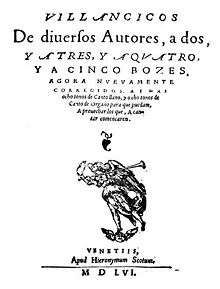Cancionero de Upsala

Cancionero de Upsala
The Cancionero de Upsala [sic] is the title commonly given to a volume of mostly anonymous Spanish music printed in Venice in 1556 and actually titled Villancicos de diuersos Autores, a dos, y a tres, y a quatro, y ya a cinco bozes...Venetiis, Apud Hieronymum Scotum, MDLVI. It survives in a unique copy at the Uppsala University Library and was edited in 1909 by Rafael Mitjana; the subsequent literature has mostly adopted his spelling "Upsala" ("Upsala" being the historic Swedish spelling of "Uppsala" until the major spelling reform of 1906). A facsimile was published by Alamire (Peer, Belgium 1984).
Contents
It is famous chiefly for the following carols or villancicos de Navidad:
VILLANCICOS DE NAVIDAD a 4 bozes
- Nola dovemos dormirla XXXII (These numbers and the following given in the table of contents are off by two; Nola... is actually found at p XXXIV)
- Rey aquien Reyes adoran XXXIII
- Verbum caro factum est XXXIIII
- Alta Reyna soberana XXXV
- Gozate virgen sacrada XXXVI
- Un niño nos es naçido XXXVII
- Dadme Albriçias hyo deva XXXVIII
- Yo me soy la morenica yo XXXIX
- Ela don don don XL
- Riu Riu Chiu la guarda XLI
VILLANCICOS DE NAVIDAD a 3 bozes
- Señores el ques nasçido de XLII
- Voy Virgen soys nuestra madre XLII
External links
- Free scores from Cancionero de Upsala in the Choral Public Domain Library (ChoralWiki)
- Digital copy of Cancionero de Upsala from Uppsala University Library
This article is issued from Wikipedia - version of the 10/20/2016. The text is available under the Creative Commons Attribution/Share Alike but additional terms may apply for the media files.